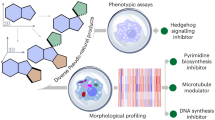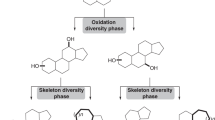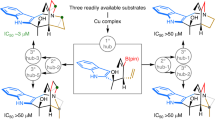Abstract
Macrocycles are key structural elements in numerous bioactive small molecules and are attractive targets in the diversity-oriented synthesis of natural product–based libraries. However, efficient and systematic access to diverse collections of macrocycles has proven difficult using classical macrocyclization reactions. To address this problem, we have developed a concise, modular approach to the diversity-oriented synthesis of macrolactones and macrolactams involving oxidative cleavage of a bridging double bond in polycyclic enol ethers and enamines. These substrates are assembled in only four or five synthetic steps and undergo ring expansion to afford highly functionalized macrocycles bearing handles for further diversification. In contrast to macrocyclization reactions of corresponding seco acids, the ring expansion reactions are efficient and insensitive to ring size and stereochemistry, overcoming key limitations of conventional approaches to systematic macrocycle synthesis. Cheminformatic analysis indicates that these macrocycles access regions of chemical space that overlap with natural products, distinct from currently targeted synthetic drugs.
This is a preview of subscription content, access via your institution
Access options
Subscribe to this journal
Receive 12 print issues and online access
$259.00 per year
only $21.58 per issue
Buy this article
- Purchase on Springer Link
- Instant access to full article PDF
Prices may be subject to local taxes which are calculated during checkout




Similar content being viewed by others
References
Driggers, E.M., Hale, S.P., Lee, J. & Terrett, N.K. The exploration of macrocycles for drug discovery–An underexploited structural class. Nat. Rev. Drug Discov. 7, 608–624 (2008).
Wessjohann, L.A., Ruijter, E., Garcia-Rivera, D. & Brandt, W. What can a chemist learn from nature's macrocycles?–A brief, conceptual view. Mol. Divers. 9, 171–186 (2005).
Sánchez-Pedregal, V.M. et al. The tubulin-bound conformation of discodermolide derived by NMR studies in solution supports a common pharmacophore model for epothilone and discodermolide. Angew. Chem. Int. Ed. Engl. 45, 7388–7394 (2006).
Canales, A. et al. The bound conformation of microtubule-stabilizing agents: NMR insights into the bioactive 3D structure of discodermolide and dictyostatin. Chem. Eur. J. 14, 7557–7569 (2008).
Knust, H. & Hoffmann, R.W. Synthesis and conformational analysis of macrocyclic dilactones mimicking the pharmacophore of aplysiatoxin. Helv. Chim. Acta 86, 1871–1893 (2003).
Khan, A.R. et al. Lowering the entropic barrier for binding conformationally flexible inhibitors to enzymes. Biochemistry 37, 16839–16845 (1998).
Benfield, A.P. et al. Ligand preorganization may be accompanied by entropic penalties in protein–ligand interactions. Angew. Chem. Int. Ed. Engl. 45, 6830–6835 (2006).
Udugamasooriya, D.G. & Spaller, M.R. Conformational constraint in protein ligand design and the inconsistency of binding entropy. Biopolymers 89, 653–667 (2008).
Veber, D.F. et al. Molecular properties that influence the oral bioavailability of drug candidates. J. Med. Chem. 45, 2615–2623 (2002).
Bauer, R.A., Wurst, J.M. & Tan, D.S. Expanding the range of 'druggable' targets with natural product-based libraries: an academic perspective. Curr. Opin. Chem. Biol. 14, 308–314 (2010).
Tan, D.S. Diversity-oriented synthesis: exploring the intersections between chemistry and biology. Nat. Chem. Biol. 1, 74–84 (2005).
Illuminati, G. & Mandolini, L. Ring closure reactions of bifunctional chain molecules. Acc. Chem. Res. 14, 95–102 (1981).
Woodward, R.B. et al. Asymmetric total synthesis of erythromycin. 2. Synthesis of an erythronolide A lactone system. J. Am. Chem. Soc. 103, 3213–3215 (1981).
Blankenstein, J. & Zhu, J. Conformation-directed macrocyclization reactions. European J. Org. Chem. 1949–1964 (2005).
Gradillas, A. & Perez-Castells, J. Macrocyclization by ring-closing metathesis in the total synthesis of natural products: reaction conditions and limitations. Angew. Chem. Int. Ed. Engl. 45, 6086–6101 (2006).
Su, Q., Beeler, A.B., Lobkovsky, E., Porco, J.A. & Panek, J.S. Stereochemical diversity through cyclodimerization: synthesis of polyketide-like macrodiolides. Org. Lett. 5, 2149–2152 (2003).
Beeler, A.B. et al. Synthesis of a library of complex macrodiolides employing cyclodimerization of hydroxy esters. J. Comb. Chem. 7, 673–681 (2005).
Schmidt, D.R., Kwon, O. & Schreiber, S.L. Macrolactones in diversity-oriented synthesis: preparation of a pilot library and exploration of factors controlling macrocyclization. J. Comb. Chem. 6, 286–292 (2004).
Marcaurelle, L.A. et al. An aldol-based build/couple/pair strategy for the synthesis of medium- and large-sized rings: discovery of macrocyclic histone deacetylase inhibitors. J. Am. Chem. Soc. 132, 16962–16976 (2010).
Stach, H. & Hesse, M. Synthesis of macrocyclic compounds by ring enlargement. Tetrahedron 44, 1573–1590 (1988).
Roxburgh, C.J. The syntheses of large-ring compounds. Tetrahedron 51, 9767–9822 (1995).
Roxburgh, C.J. Syntheses of medium sized rings by ring expansion reactions. Tetrahedron 49, 10749–10784 (1993).
Bäurle, S. et al. From rigidity to conformational flexibility: macrocyclic templates derived from ansa-steroids. Angew. Chem. Int. Ed. Engl. 42, 3961–3964 (2003).
Bäurle, S. et al. Novel macrocyclic templates by ring enlargement of ansa-steroids. Tetrahedr. Lett. 45, 9569–9571 (2004).
Kumar, N., Kiuchi, M., Tallarico, J.A. & Schreiber, S.L. Small-molecule diversity using a skeletal transformation strategy. Org. Lett. 7, 2535–2538 (2005).
Borowitz, I.J. & Gonis, G. The synthesis and oxidation of tetrahydrochroman. A new lactone synthesis. Tetrahedr. Lett. 5, 1151–1155 (1964).
Borowitz, I.J. & Williams, G.J. Medium ring compounds part II. The synthesis of 6-oxodecanolide. Tetrahedr. Lett. 6, 3813–3817 (1965).
Borowitz, I.J. & Rapp, R.D. Ozonolysis of tetrahydrochromans. Formation of glycols and normal ozonolysis products. J. Org. Chem. 34, 1370–1373 (1969).
Hückel, W., Danneel, R., Schwartz, A. & Gercke, A. Stereochemistry of bicyclic ring systems. V. Δ9,10-Octalin. Justus Liebigs Ann. Chem. 474, 121–144 (1929).
Seebach, D., Weller, T., Protschuk, G., Beck, A.K. & Hoekstra, M.S. Preparation of 1,3-diketones and of nitrodiketones by (1:1)-acylation of lithium enolates with acyl chlorides. Helv. Chim. Acta 64, 716–735 (1981).
Patil, M.L., Borate, H.B., Ponde, D.E. & Deshpande, V.H. Total synthesis of (±)-brasiliquinone B. Tetrahedron 58, 6615–6620 (2002).
Pérez Sestelo, J., Real, M.M. & Sarandeses, L.A. Synthesis of polycyclic structures by the Diels-Alder reaction of inner-outer-ring 1,3-bis(trimethylsilyloxy)dienes. J. Org. Chem. 66, 1395–1402 (2001).
Pérez Sestelo, J., Real, M.M., Mourino, A. & Sarandeses, L.A. Synthesis of polycyclic structures by Diels–Alder reaction of inner-outer-ring 1,3-bis[(trimethylsilyl)oxy]dienes. Tetrahedr. Lett. 40, 985–988 (1999).
Danishefsky, S., Kerwin, J.F. Jr. & Kobayashi, S. Lewis acid catalyzed cyclocondensations of functionalized dienes with aldehydes. J. Am. Chem. Soc. 104, 358–360 (1982).
Inokuchi, T., Okano, M. & Miyamoto, T. Catalyzed Diels-Alder reaction of alkylidene- or arylideneacetoacetates and Danishefsky's dienes with lanthanide salts aimed at selective synthesis of cis-4,5-dimethyl-2-cyclohexenone derivatives. J. Org. Chem. 66, 8059–8063 (2001).
Dossetter, A.G., Jamison, T.F. & Jacobsen, E.N. Highly enantio- and diastereoselective hetero-Diels–Alder reactions catalyzed by new chiral tridentate chromium (III) catalysts. Angew. Chem. Int. Ed. Engl. 38, 2398–2400 (1999).
Gemal, A.L. & Luche, J.L. Lanthanoids in organic synthesis. 6. Reduction of α-enones by sodium borohydride in the presence of lanthanoid chlorides: synthetic and mechanistic aspects. J. Am. Chem. Soc. 103, 5454–5459 (1981).
Yang, D. & Zhang, C. Ruthenium-catalyzed oxidative cleavage of olefins to aldehydes. J. Org. Chem. 66, 4814–4818 (2001).
Carlsen, P.H.J., Katsuki, T., Martin, V.S. & Sharpless, K.B. A greatly improved procedure for ruthenium tetroxide catalyzed oxidations of organic compounds. J. Org. Chem. 46, 3936–3938 (1981).
Brown, D.S., Elliott Mark, C., Moody, C.J. & Mowlem, T.J. Preparation of oxonanes and azonanes by oxidative ring expansion: synthesis of obtusan. J. Chem. Soc. Perkin Trans. I 1137–1144 (1995).
Torii, S., Inokuchi, T. & Kondo, K. A facile procedure for oxidative cleavage of enolic olefins to the carbonyl compounds with ruthenium tetroxide (RuO4). J. Org. Chem. 50, 4980–4982 (1985).
Rincón, S. et al. A new route for the preparation of the 22,23-dioxocholestane side chain from diosgenin and its application to the stereocontrolled construction of the 22R,23S-diol function. Tetrahedron 62, 2594–2602 (2006).
Shiina, I., Kubota, M. & Ibuka, R. A novel and efficient macrolactonization of ω-hydroxycarboxylic acids using 2-methyl-6-nitrobenzoic anhydride (MNBA). Tetrahedr. Lett. 43, 7535–7539 (2002).
Shiina, I., Kubota, M., Oshiumi, H. & Hashizume, M. An effective use of benzoic anhydride and its derivatives for the synthesis of carboxylic esters and lactones: a powerful and convenient mixed anhydride method promoted by basic catalysts. J. Org. Chem. 69, 1822–1830 (2004).
Tanner, D. & Somfai, P. A mild and efficient method for the preparation of N-tosyl amides and lactams. Tetrahedron 44, 613–618 (1988).
Dumez, E. et al. Synthesis of macrocyclic, potential protease inhibitors using a generic scaffold. J. Org. Chem. 67, 4882–4892 (2002).
Ganesan, A. The impact of natural products upon modern drug discovery. Curr. Opin. Chem. Biol. 12, 306–317 (2008).
Sauer, W.H.B. & Schwarz, M.K. Molecular shape diversity of combinatorial libraries: a prerequisite for broad bioactivity. J. Chem. Inf. Comput. Sci. 43, 987–1003 (2003).
Boström, J., Norrby, P.-O. & Liljefors, T. Conformational energy penalties of protein-bound ligands. J. Comput. Aided Mol. Des. 12, 383–396 (1998).
Akritopoulou-Zanze, I., Metz, J.T. & Djuric, S.W. Topography-biased compound library design: the shape of things to come? Drug Discov. Today 12, 948–952 (2007).
Acknowledgements
Dedicated to the memory of our colleague and mentor, David Y. Gin (1967–2011). We thank I. Shiina (Tokyo University of Science) for the generous gift of MNBA; G. Sukenick, H. Liu, H. Fang and S. Rusli (Memorial Sloan-Kettering Cancer Center Analytical Core Facility) for expert mass spectral analyses; and K. Kirschbaum (University of Toledo) for X-ray crystallographic analysis. Financial support from the NIH (P41 GM076267), Starr Foundation, Alfred P. Sloan Foundation (Research Fellowship to D.S.T.) and Deutscher Akademischer Austauschdienst (DAAD, postdoctoral fellowship to F.K.) is gratefully acknowledged.
Author information
Authors and Affiliations
Contributions
F.K., C.F.S. and D.S.T. designed the experiments. F.K. and C.F.S. carried out the synthetic experiments. C.F.S. carried out the PCA analysis. L.B.A. carried out the PMI analysis. F.K., C.F.S. and D.S.T. analyzed the data. F.K., C.F.S. and D.S.T. wrote the manuscript.
Corresponding author
Ethics declarations
Competing interests
The authors declare no competing financial interests.
Supplementary information
Supplementary Text and Figures
Supplementary Methods and Supplementary Results (PDF 66330 kb)
Supplementary Data Set 1
PCA Data for Figure 4a–c and Supplementary Figure 5 (XLS 961 kb)
Supplementary Data Set 2
PMI Data for Figure 4d, Supplementary Figure 6 and Supplementary Figure 7 (XLS 1406 kb)
Rights and permissions
About this article
Cite this article
Kopp, F., Stratton, C., Akella, L. et al. A diversity-oriented synthesis approach to macrocycles via oxidative ring expansion. Nat Chem Biol 8, 358–365 (2012). https://doi.org/10.1038/nchembio.911
Received:
Accepted:
Published:
Issue Date:
DOI: https://doi.org/10.1038/nchembio.911
This article is cited by
-
Comprehensive exploration of chemical space using trisubstituted carboranes
Scientific Reports (2021)
-
A general strategy for diversifying complex natural products to polycyclic scaffolds with medium-sized rings
Nature Communications (2019)
-
Diversity-oriented synthetic strategy for developing a chemical modulator of protein–protein interaction
Nature Communications (2016)
-
Probing chemical space with alkaloid-inspired libraries
Nature Chemistry (2014)
-
Writing the macrocycle manual
Nature Chemical Biology (2014)



